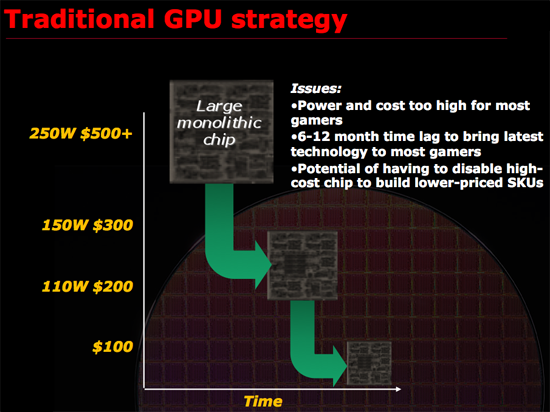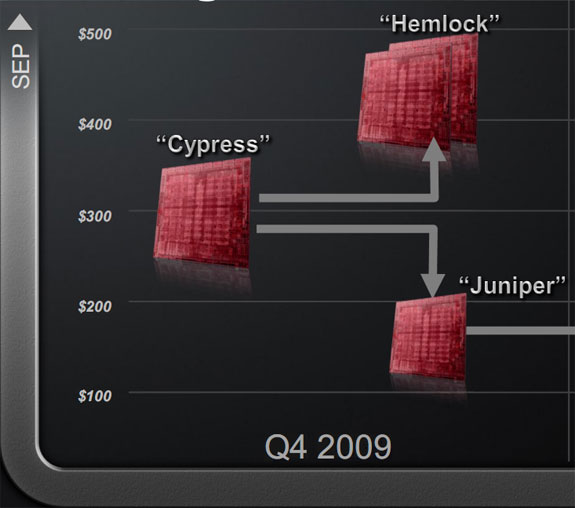The RV870 Story: AMD Showing up to the Fight
by Anand Lal Shimpi on February 14, 2010 12:00 AM EST- Posted in
- GPUs
What Made it All Ok: 4 GPUs in < 6 Months
Through a lot of hard work and sacrifice, even on Carrell’s part, ATI cut the RV870 from as much as 22mm on a side down to roughly 18mm x 18mm. The problem is that RV770 was around 16mm on a side. The RV870 was still too big.
Carrell wanted to cut it down even more, but two things changed his mind. First, in order to build 870 in the space of a 770 ATI would have to cut out much more from the chip than Carrell originally tought. One of the things that would have to go was some of the shader core.
In order to run the GDDR5 memory at the sort of data rates that ATI was targeting for the 5870 the analog PHYs on the chip had to grow considerably. At 16mm on a side ATI would either have to scale back memory bandwidth or eat into the shader core area. Either way we would’ve had a slower chip.
I asked Carrell if 16mm on a side would’ve made the RV870 $100 cheaper at launch, putting it on par with the RV770 launch prices. He said no. I didn’t find out why until much later, but I’ll save that story for another time.
Sacrificing performance to meet the 16mm x 16mm die size targets wasn’t going to happen, but what ultimately convinced Carrell to go with a larger die this time around was something that ATI didn’t get nearly enough praise for: the ability to launch 4 different 40nm DirectX 11 GPUs in less than 6 months.
Remember that Carrell’s beef with building the biggest GPU possible is that it takes too long for the majority of customers to get access to derivatives of that GPU. Look at how long it took G80 or GT200 to scale down. And who knows when we’ll see $150 Fermi/GF100 derivatives.

But ATI Engineering promised two things. First, that Cypress would have a successor called Juniper that would be ready around the same time. Secondly, two more GPUs would follow and the whole stack will be done and out in less than 6 months. ATI came close in 2008 with 3 GPUs in 3 months, but the fourth member of the 4000 series didn’t show up until April of 2009.
It wasn’t an impossible feat. ATI does have concurrent design teams and a lot of engineering resources in India/China. By working on Juniper in tandem with Cypress, assuming there were no show stopping bugs, ATI could exploit efficiencies in two teams effectively working on the same hardware (Juniper was just half a Cypress).
The idea of taking such a huge risk made Carrell uncomfortable. Running two GPU designs in parallel, for the same family of chips, is risky. If everything works out perfectly, you get two chips out at the same time. If it doesn’t, you’ve just tied up two design teams on one product generation. A slip here would give ATI its own Fermi.
What ultimately sold Carrell was the fact that engineering told him that they believed they could pull it off. Carrell believes in people. He believes if you expect the best out of those around you, then that’s what you’ll get. He couldn’t reconcile his beliefs with doubting the schedule engineering was feeding him. Carrell nervously signed off and the Evergreen stack was born.

Cypress and Juniper were delivered nearly at the same time. In fact, Juniper was ready a bit earlier and was sampled to developers months before ATI launched the 5000 series. Cedar and Redwood followed, not to mention a dual-Cypress board that became the Radeon HD 5970. And all of this was done and ready in less than 6 months (the chips themselves were all ready within 4 months).
When the smoke cleared ATI had new DirectX 11 parts at $600, $400, $300, $200, $150, $100 and $60. The Windows 7/DirectX 11 market bulge just got serviced.










132 Comments
View All Comments
Spoelie - Thursday, February 18, 2010 - link
phoronix.comfor all things ATi + Linux
SeanHollister - Monday, February 15, 2010 - link
Fantastic work, Anand. It's so difficult to make pieces like this work without coming across as puffery, but everything here feels genuine and evenhanded. Here's hoping for similar articles featuring individuals at NVIDIA, Intel and beyond in the not-too-distant future.boslink - Monday, February 15, 2010 - link
Just like many others i'm also reading/visiting anandtech for years but this article made me register just to say damn good job.Also for the long time i didn't read article from cover to cover. Usually i read first page and maybe second (enough to guess what's in other pages) and than skip to conclusions.
But this article remind us that Graphic card/chip is not only silicon. Real people story is what makes this article great.
Thanks Anand
AmdInside - Monday, February 15, 2010 - link
Great article as usual. Sunspot seems like the biggest non-factor in the 5x00 series. Except for hardware reviews sites which have lots of monitors lying around, I just don't see a need for it. It is like NVIDIA's 3D Vision. Concept sounds good but in general practice, it is not very realistic that a user will use it. Just another check box that a company can point to to an OEM and say we have it and they don't. NVIDIA has had Eyefinity for a while (SLI Mosaic). It just is very expensive since it is targeted towards businesses and not consumers and offers some features Eyefinity doesn't offer.I think NVIDIA just didn't believe consumers really wanted it but added it afterwards just so that ATI doesn't have a checkbox they can brag about. But NVIDIA probably still believes this is mainly a business feature.It is always interesting to learn how businesses make product decisions internally. I always hate reading interviews of PR people. I learn zero. Talk to engineers if you really want to learn something.
BelardA - Tuesday, February 16, 2010 - link
I think the point of Eyefinity is that its more hardware based and natural... not requiring so much work from the game publisher. A way of having higher screen details over a span of monitors.A few games will actually span 2 or 3 monitors. Or some will use the 2nd display as a control panel. With Eyefinity, it tells the game "I have #### x #### pixels" and auto divides the signal onto 3 or 6 screens and be playable. That is quite cool.
But as you say, its a bit of a non-factor. Most users will still only have one display to work with. Hmmm. there was a monitor that was almost seamless 3-monitors built together, where is that?
Also, I think the TOP-SECRET aspect of Sun-Spots was a way of testing security. Eyefinity isn't a major thing... but the hiding of it was.
While employees do move about in the business, the sharing of trade-secrets could still get them in trouble - if caught. It does happen, but how much?
gomakeit - Monday, February 15, 2010 - link
I love these insightful articles! This is why Anandtech is one of my favorite tech sites ever!Smell This - Monday, February 15, 2010 - link
Probably could have done without the snide reference to the CPU division at the end of the article - it added nothing and was a detraction from the overall piece.It also implies a symbiotic relationship between AMDs 40+ year battle with Chipzilla and the GPU Wars with nV. Not really an accurate correlation. The CPU division has their own headaches.
It is appropriate to note, however, that both divisions must bring their 'A' Game to the table with the upcoming convergence on-die of the CPU-GPU.
mrwilton - Monday, February 15, 2010 - link
Thank you, Anand, for this great and fun-to-read article. It really has been some time where I have read an article cover to cover.Keep up the excellent work.
Best wishes, wt
Ananke - Monday, February 15, 2010 - link
I have 5850, it is a great card. However, what people saying about PC gaming is true - gaming on PC slowly fades towards consoles. You cannot justify several thousand-dollar PC versus a 2-300 multimedia console.So powerful GPU is a supercomputer by itself. Please ATI, make better Avivo transcoder, push open software development using Steam further. We need many applications, not just Photoshop and Cyberlink. We need hundreds, and many free, to utilize this calculation power. Then, it will make sense to use this cards.
erple2 - Tuesday, February 16, 2010 - link
Perhaps. However, this "PC Gaming is being killed off by the 2-300 multimedia console" war has been going on since the Playstation 1 came out. PC gaming is still doing very well.I think that there will always be some sort of market (even if only 10% - that's significant enough to make companies take notice) for PC Gaming. While I still have to use the PC for something, I'll continue to use it for gaming, as well.
Reading the article, I find it poignant that the focus is on //execution// rather than //ideas//. It reminds me of a blog written by Jeff Atwood (http://www.codinghorror.com/blog/2010/01/cultivate...">http://www.codinghorror.com/blog/2010/01/cultivate... if you're interested) about the exact same thing. Focus on what you //do//. Execution (ie "what do we have an 80%+ chance of getting done on time) is more important than the idea (ie features you can claim on a spec sheet).
As a hardware developer (goes the same for any software developer), your job is to release the product. That means following a schedule. That means focusing on what you can do, not on what you want to do. It sounds to me like ATI has been following that paradigm, which is why they seem to be doing so well these days.
What's particularly encouraging about the story written was that Management had the foresight to actually listen to the technical side when coming up with the schedules and requirements. That, in and of itself, is something that a significant number of companies just don't do well.
It's nice to hear from the internal wing of the company from time to time, and not just the glossy presentation of hardware releases.
I for one thoroughly enjoyed the read. I liked the perspective that the RV5-- err Evergreen gave on the process of developing hardware. What works, and what doesn't.
Great article. Goes down in my book with the SSD and RV770 articles as some of the best IT reads I've done.